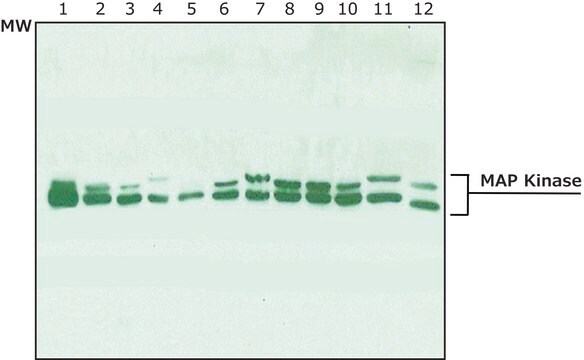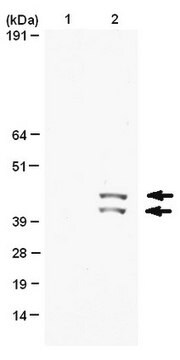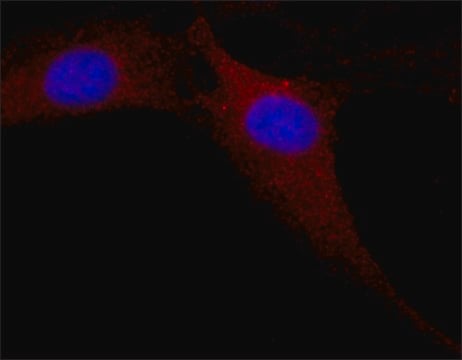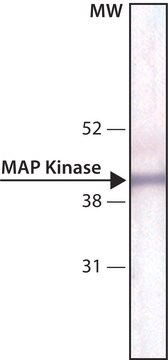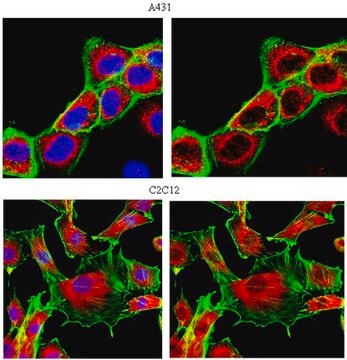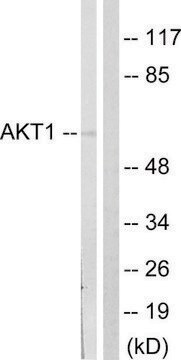M8159
Monoklonale Anti-MAP-Kinase, aktiviert (Diphosphorylierter ERK-1&2) in Maus hergestellte Antikörper
clone MAPK-YT, ascites fluid
Synonym(e):
Anti-DP-ERK aus mouse
About This Item
Empfohlene Produkte
Biologische Quelle
mouse
Qualitätsniveau
Konjugat
unconjugated
Antikörperform
ascites fluid
Antikörper-Produkttyp
primary antibodies
Klon
MAPK-YT, monoclonal
Mol-Gew.
antigen ERK-1 44 kDa
antigen ERK-2 42 kDa
Enthält
15 mM sodium azide
Speziesreaktivität
human, Caenorhabditis elegans, Xenopus, Drosophila, hamster, rat, bovine, mouse, yeast
Methode(n)
immunocytochemistry: suitable
immunohistochemistry (formalin-fixed, paraffin-embedded sections): suitable
immunoprecipitation (IP): suitable
indirect ELISA: suitable
western blot: 1:10,000 using rat brain extract
Isotyp
IgG1
UniProt-Hinterlegungsnummer
Versandbedingung
dry ice
Lagertemp.
−20°C
Posttranslationale Modifikation Target
unmodified
Angaben zum Gen
human ... MAPK1(5594) , MAPK3(5595)
mouse ... Mapk1(26413) , Mapk3(26417)
rat ... Mapk1(116590) , Mapk3(50689)
Suchen Sie nach ähnlichen Produkten? Aufrufen Leitfaden zum Produktvergleich
Allgemeine Beschreibung
Spezifität
Immunogen
Anwendung
Monoclonal Anti-MAP Kinase, Activated (Diphosphorylated ERK-1&2) may be used for the localization of the active, dually-phosphorylated, form of MAP kinase using various immunochemical assays such as immunoblotting of cultured cells and tissue extracts, ELISA, immunocytochemistry, immunoprecipitation, and in immunohistochemistry (formalin and formaldehyde-fixed sections). Reactivity has been observed with human, bovine, rat, mouse, Drosophila, Spodoptera frugiperda, and yeast.
Monoclonal Anti-MAP Kinase, activated (Diphosphorylated ERK-1&2) antibody has been used in plasmid and transient transfection and western blotting.
Biochem./physiol. Wirkung
Physikalische Form
Lagerung und Haltbarkeit
Haftungsausschluss
Sie haben nicht das passende Produkt gefunden?
Probieren Sie unser Produkt-Auswahlhilfe. aus.
Lagerklassenschlüssel
12 - Non Combustible Liquids
WGK
WGK 2
Flammpunkt (°F)
Not applicable
Flammpunkt (°C)
Not applicable
Analysenzertifikate (COA)
Suchen Sie nach Analysenzertifikate (COA), indem Sie die Lot-/Chargennummer des Produkts eingeben. Lot- und Chargennummern sind auf dem Produktetikett hinter den Wörtern ‘Lot’ oder ‘Batch’ (Lot oder Charge) zu finden.
Besitzen Sie dieses Produkt bereits?
In der Dokumentenbibliothek finden Sie die Dokumentation zu den Produkten, die Sie kürzlich erworben haben.
Kunden haben sich ebenfalls angesehen
Artikel
Alzheimer's Disease
Unser Team von Wissenschaftlern verfügt über Erfahrung in allen Forschungsbereichen einschließlich Life Science, Materialwissenschaften, chemischer Synthese, Chromatographie, Analytik und vielen mehr..
Setzen Sie sich mit dem technischen Dienst in Verbindung.